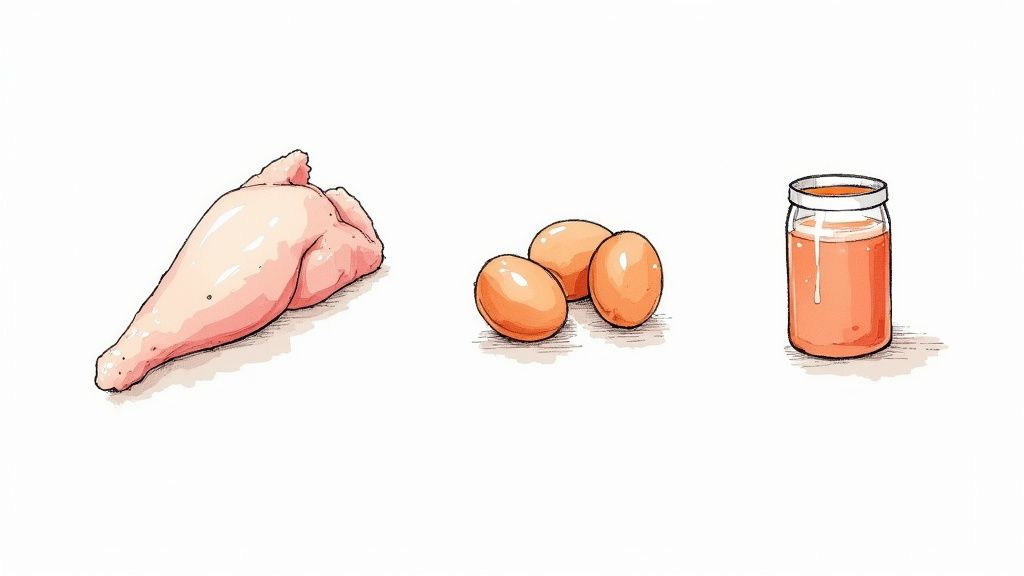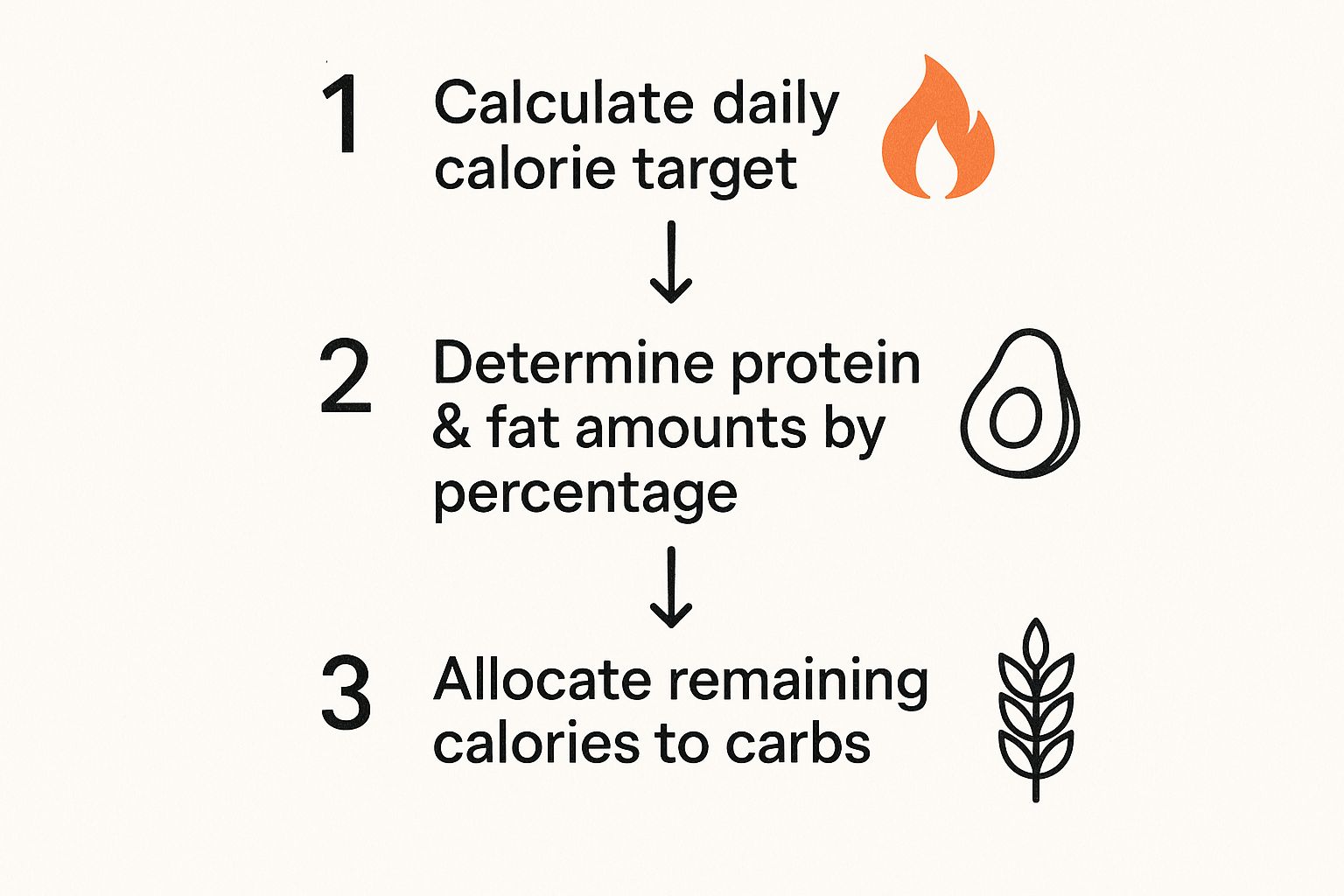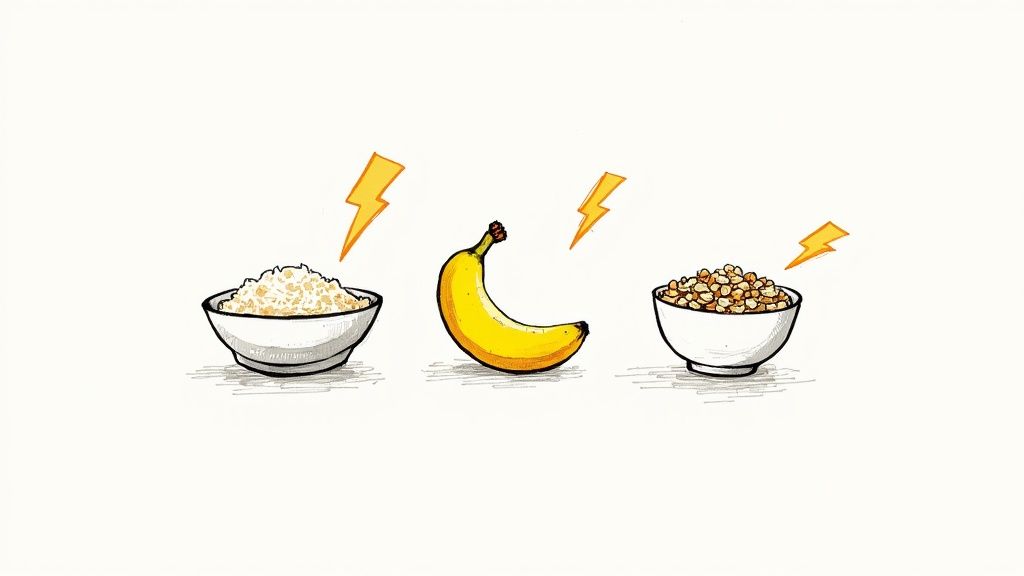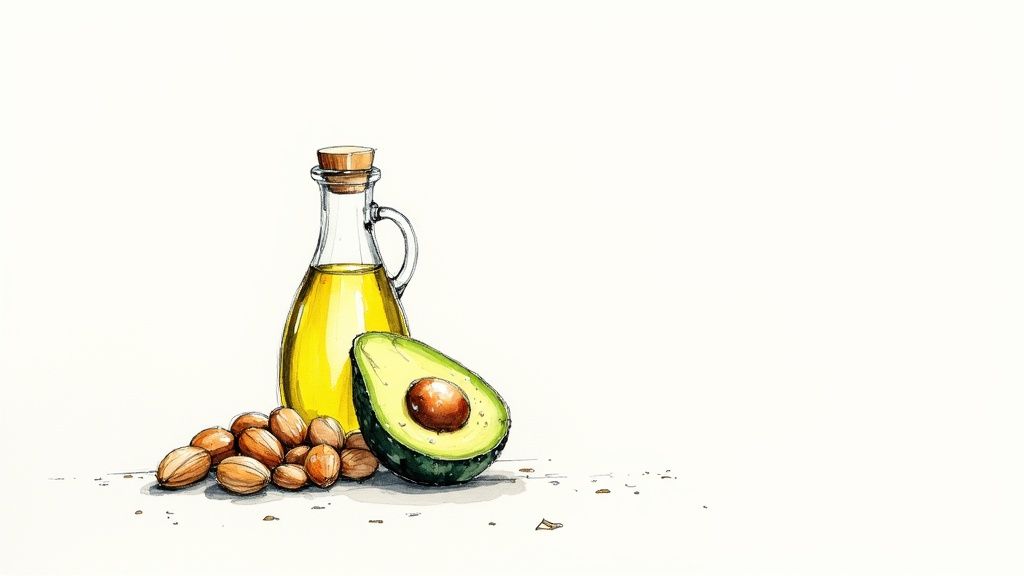The Smart Eater's Guide to Macros for Muscle Gain (Without the Stress)
Discover the recommended macros for muscle gain to optimize your workouts. Learn proven tips for effective, stress-free muscle building.
Posted by
Trying to build muscle can feel like you need a degree in nutrition, but it’s way simpler than it looks. The whole idea of recommended macros for muscle gain isn’t some top-secret formula. It’s really just about giving your body the right fuel from three key sources: protein, carbohydrates, and fats. Once you get the hang of it, you'll be on the fast track to seeing results without all the guesswork.
First Off, What Are Macros and Why Do They Matter?
If you’ve heard "macros" thrown around online, don't sweat it. It's just a shorter, less science-y way of saying macronutrients. Think of them as the big three nutrients that make up pretty much everything you eat.
Every food has some mix of these three, and each one plays a huge role in your body—especially when your goal is to build a little muscle.
Meet Your Muscle-Building Team
Imagine you're building a house. You wouldn't just use bricks, right? You'd need wood for the frame, concrete for the foundation, and a crew to put it all together. Your macros work the same way.
Protein (The Builder): This is the star of the show, and for good reason. Protein is made of amino acids, which are literally the building blocks your body uses to repair and grow muscle after a workout. Lifting weights creates tiny tears in your muscles, and protein is what patches them up, making them bigger and stronger.
Carbohydrates (The Energy Crew): Carbs get a bad rap sometimes, but if you want to build muscle, they're your best friend. They’re your body’s main fuel source, giving you the energy to crush your workouts. Skip the carbs, and you’ll feel drained, weak, and unable to train hard enough to actually see growth.
Fats (The Support Staff): Healthy fats are the unsung heroes here. They’re essential for producing key hormones, including testosterone, which is super important for muscle growth. Fats also help your body absorb vitamins and keep your whole system running smoothly.
A balanced approach is everything. Focusing only on protein while cutting out carbs and fats is like hiring a construction crew but forgetting to give them power tools. All three have to work together.
Getting this team dynamic right is the first big step. You don't need a massive spreadsheet to get started. It’s about being mindful that your post-workout meal—the chicken breast (protein), sweet potato (carbs), and avocado (fats)—is a complete system working to help you reach your goals.
This is the kind of easy awareness that makes tracking feel less like a chore. It’s something you can do just by talking to your phone with an app like Munchlog.
Your Starting Point for Muscle Gain Macros

Alright, let's talk numbers—but don't worry, you won’t need a calculator. When you're trying to gain muscle, there isn’t a single magic ratio that works for everyone. Think of it more like a flexible starting point that gives your body what it needs to build, fuel, and recover.
A great approach for most people is to build a plan that puts protein first without forgetting about the other two. This sets you up for success, ensuring your muscles get repaired while your body has the energy it needs for your workouts.
A Popular and Effective Macro Ratio
So, where do you begin? A commonly recommended split for muscle gain is 45% carbohydrates, 30% protein, and 25% fat. This ratio usually hits the sweet spot. It gives you plenty of protein for muscle repair, a good amount of carbs to power your training, and enough healthy fats to keep your hormones and overall health in check.
Let's make that real. If you're eating 2,000 calories a day, this ratio breaks down to about 225 grams of carbs, 150 grams of protein, and 55 grams of fat.
Of course, this all starts with knowing your total daily calorie target. If you're not sure what that is, our simple guide on how to calculate your daily calorie needs is the perfect place to start.
This isn't a set of rigid rules. Think of it as your nutritional North Star—a reliable guide to point you in the right direction. Some days you might eat a little more fat, other days more carbs. The goal is consistency over perfection.
To make this crystal clear, let's see how this popular ratio looks at different calorie levels. Seeing the actual grams can make planning your meals feel much less abstract.
Sample Daily Macro Goals for Muscle Gain
Here’s a quick look at how a 45% Carb / 30% Protein / 25% Fat ratio breaks down at different daily calorie levels.
| Daily Calories | Carbohydrates (grams) | Protein (grams) | Fat (grams) |
|---|---|---|---|
| 1,800 | 203g | 135g | 50g |
| 2,200 | 248g | 165g | 61g |
| 2,600 | 293g | 195g | 72g |
| 3,000 | 338g | 225g | 83g |
Seeing the numbers laid out like this makes it feel much more manageable, right? This isn’t about hitting these targets to the exact gram every single day. It's about being mindful of your choices—like adding a scoop of Greek yogurt for more protein or grabbing a banana before your workout for that carb boost.
And remember, you don't have to do all this math in your head. When you tell Munchlog.ai you had “a chicken salad sandwich and an apple,” it does the heavy lifting for you, showing you how your meal fits into your daily goals. For a deeper dive into fine-tuning your diet, check out these 8 proven macros for muscle gain strategies.
How to Personalize Your Macro Targets
Okay, you've got the basics down. Now, let's make this real and tailor those numbers just for you. Personalizing your macros isn't about getting lost in complex spreadsheets; it's about building a simple, flexible plan that fits your body and your life.
To walk you through it, let's use a real-world example. Meet Alex, a busy professional who wants to build muscle but needs a diet that's easy to stick to.
We’ll break it down into three simple steps.
Step 1: Find Your Daily Calorie Goal
First things first, you need a calorie target. The easiest way to figure this out is to estimate your Total Daily Energy Expenditure (TDEE). Think of this as the total number of calories your body burns just by living, working, and hitting the gym.
To build muscle, you need to eat a little bit more than you burn—this is called a calorie surplus. Aiming for a modest surplus of 250-500 calories above your TDEE is the sweet spot. It gives your body the extra fuel it needs to build new muscle without packing on unwanted body fat.
Let’s say Alex’s TDEE is around 2,200 calories. He adds 300 calories to create that gentle surplus, landing him at a daily goal of 2,500 calories.
Step 2: Calculate Your Protein and Fat
Once your calorie goal is set, you can figure out your protein and fat targets. We'll use the percentages we talked about earlier: 30% protein and 25% fat.
Here’s how the math works out for Alex’s 2,500-calorie plan:
- Protein: 2,500 calories x 0.30 = 750 calories. Since protein has 4 calories per gram, that’s about 188g of protein.
- Fat: 2,500 calories x 0.25 = 625 calories. Fat is more dense at 9 calories per gram, which means his target is about 69g of fat.
See how we're working our way down from the big picture (total calories) to the smaller details?

This visual really helps simplify the process, turning what seems like a lot of math into a clear, daily game plan.
Step 3: Fill the Rest with Carbs
Last but not least, we fill in the remaining calories with carbohydrates. These are your body’s go-to energy source, powering you through those workouts.
Here's how Alex finishes his calculation:
His total goal is 2,500 calories. He’s already accounted for protein (750 calories) and fat (625 calories), which adds up to 1,375 calories. So, he just subtracts that from his total: 2,500 - 1,375 = 1,125 calories left for carbs.
Since carbs have 4 calories per gram (just like protein), Alex's daily target is 281g of carbs.
And there you have it! Alex's personalized starting point is 188g protein, 69g fat, and 281g carbs. These aren't strict rules, but they are a fantastic baseline to get started. From here, he can easily track his meals just by telling Munchlog.ai something like "a protein shake and a banana," and letting the app do all the math for him.
If you want to dig a bit deeper into the calculations, you can find more tools in our guide on using a protein, carb, and fat ratio calculator.
How Athletes Tweak Their Macros for an Edge

While our goal is to build a simple plan that fits into everyday life, it’s always interesting to see how the pros do it. Pro athletes don't just eat; they fuel. Their macro ratios are dialed in with a level of precision that matches their demanding training schedules.
For an elite athlete, food is a strategic tool. Think of an endurance runner who slowly increases their carb intake before a marathon—a classic case of "carb-loading" to max out their energy. Or a competitive bodybuilder, who might stick to a super high-protein diet to push muscle growth to its absolute limit.
Now, this doesn't mean you should start eating like a bodybuilder. The real takeaway here is that our nutritional needs change based on our goals and activity levels. It just proves there's no magic, one-size-fits-all formula.
Fueling for Peak Performance
So, what do these elite recommendations look like? Athletes often calculate their macros in grams per kilogram of body weight for more precise control. Simply put, their physical demands are way higher, so their fuel requirements are, too.
For example, the International Olympic Committee (IOC) suggests athletes trying to build muscle can go as high as 1.8 to 2.7 grams of protein per kilogram of body weight. For a 175-pound (80 kg) athlete, that could be a whopping 216 grams of protein a day—way more than most of us need to see great results.
Likewise, leading sports medicine groups often recommend 5 to 10 grams of carbohydrates per kilogram of body weight to keep an athlete's energy tank full. If you want to dive into the nitty-gritty, you can explore the full athletic nutritional guidelines and see the science for yourself.
Don't get bogged down by the exact numbers. The big idea is this: higher activity demands more fuel. As you get more active, your body will naturally crave more energy from carbs and more building blocks from protein to perform and recover.
Understanding this helps put your own journey into perspective. You’ll start to notice that on a really active day, a little extra snack with carbs makes you feel a whole lot better.
This is where casually tracking with an app like Munchlog.ai is so helpful. You just tell it what you ate, and it gives you instant feedback, helping you learn to listen to your body’s signals without any of the stress or obsession.
What a Day of Eating for Muscle Gain Looks Like

All the numbers are great, but what does hitting your macros actually look like on your plate? Let’s bring this to life. This isn’t a strict meal plan, but more of a simple blueprint to show you how you can reach your targets with normal, delicious food.
The whole point is to show that fueling for muscle growth doesn't mean you're stuck eating bland, boring meals. It’s just about making smart, balanced choices that you’ll actually enjoy eating.
A Sample Day of Delicious Fuel
Here’s a simple, tasty breakdown for a day that nails a muscle-focused macro split. You'll notice a pattern: every meal has a good source of protein, carbs for energy, and some healthy fats.
Breakfast (approx. 450 calories): Start your day with a bowl of Greek yogurt topped with a handful of berries and a sprinkle of granola. You get a big protein hit from the yogurt, slow-burning carbs from the granola's oats, and a dose of antioxidants from the berries. It’s a classic for a reason.
Lunch (approx. 550 calories): A grilled chicken salad wrap is a perfect midday meal. Just stuff a whole-wheat tortilla with sliced grilled chicken, mixed greens, avocado, and a light vinaigrette. It's balanced, keeps you full, and is easy to pack if you're on the go.
Dinner (approx. 600 calories): For your final meal, think baked salmon with a side of roasted sweet potato and steamed broccoli. This is a powerhouse meal, loaded with high-quality protein, complex carbs, and those all-important omega-3 fatty acids.
See? You can eat incredibly well without spending your life in the kitchen or giving up on flavor.
Don't Forget the Snacks
Snacks are your secret weapon. Seriously. They’re what help you hit your protein goals and keep your energy levels steady between meals. Think of them as a way to top up any macros you're falling a bit short on.
Your snacks should work for you, not against you. A well-timed snack can bridge the gap between meals, prevent you from getting overly hungry, and provide the extra protein your muscles need for recovery and growth.
A few easy and effective options to keep in your back pocket:
- A protein shake with a banana right after your workout
- A handful of almonds and an apple
- Cottage cheese with some sliced peaches
- A couple of hard-boiled eggs
While today's plans are all about balance, it's interesting to look back at old-school bodybuilding diets. Many were incredibly heavy on carbohydrates to fuel those grueling training sessions. We now have plenty of research showing that high-carb diets are fantastic for replenishing muscle glycogen—your body’s main fuel tank during a workout. If you want to dive deeper, you can learn more about macronutrient considerations for athletes and see how these ratios really support recovery.
The best part? You don't have to sit there with a calculator for any of this. Just tell Munchlog.ai, "I had a protein shake and a banana," and it handles the tracking for you. It's that simple.
Track Your Macros Effortlessly with Munchlog.ai
So, you now have a good handle on what macros are, why they matter for building muscle, and how to figure out your own targets. But let's be real. The thought of weighing, calculating, and logging every single thing you eat can feel like a part-time job you definitely didn't sign up for.
This is exactly where most people get overwhelmed and give up. The good news? It doesn't have to be that hard.
Ditch the Manual Math
We built Munchlog.ai specifically to remove all that friction. Forget about manually searching for every ingredient and doing endless math. Instead, you can just say what you ate, as if you were talking to a friend.
For instance, you can simply say:
- "I had a coffee with milk and a protein bar for a snack."
- "For dinner, I ate a big bowl of my homemade chili."
- "Just finished a post-workout protein shake with a banana."
Our AI takes it from there, breaking down your meals and giving you a clear, visual snapshot of your daily macros. No tedious typing required. This approach helps you stay aware of what you're eating without adding another layer of stress to your day, making it way easier to stick with your plan.
The key to long-term success isn't perfection; it's consistency. By making tracking feel effortless, you’re more likely to build a sustainable habit that supports your muscle gain journey.
While Munchlog.ai has your nutrition covered, don't forget that tracking your training is just as important. Pairing our tool with one of the best workout tracking apps creates a powerful combination for seeing real results.
Your Nutrition Partner
This simple, conversational approach connects all the dots. You can use your personalized macro targets as a guide and let Munchlog.ai handle the day-to-day details. It's the perfect way to put your knowledge into practice and stay mindful of your nutrition, even when life gets hectic.
To see just how simple it can be, take a closer look at our guide on getting the most out of a free macro tracking app.
Common Questions About Macros for Muscle Gain
Alright, let's tackle a few common questions that pop up when you're just getting started. It's totally normal to have a few "what ifs" running through your head, so here are some quick answers to put your mind at ease.
Do I Need to Hit My Macros Perfectly Every Day?
Heck no! The goal here is consistency, not perfection.
Think of your macro targets as a GPS destination, not a tightrope you have to walk. Some days you’ll be a little over on carbs, other days a bit under on fats—that’s just life. The key is to stay in the ballpark.
Focus on nailing your protein goal and getting close to your total calories most days of the week. Real progress is built over weeks and months of solid effort, not one single "perfect" day.
Can I Get Enough Protein as a Vegetarian or Vegan?
Absolutely. It’s a common concern, but building muscle on a plant-based diet is entirely achievable.
You just have to be a little more strategic. Load up on high-quality sources like:
- Lentils and chickpeas
- Tofu and tempeh
- Edamame
- Quinoa
While you might need to combine different foods to get all the essential amino acids, hitting your protein target for muscle growth is well within reach without touching meat or dairy.
Remember, your body uses rest days to repair and build muscle tissue—that process requires plenty of fuel and building blocks from protein!
Should My Macros Change on Rest Days?
For most people, keeping things simple is the best bet. Just stick to the same macros every single day.
While some advanced lifters experiment with "carb cycling" (lowering carbs on non-training days), it adds a layer of complexity that’s frankly unnecessary for the vast majority of us to see fantastic results.
Your body is in full-on repair mode on your days off, and that recovery process demands energy and nutrients. Consistent fuel helps you recover better and grow stronger. Keep it simple and sustainable.
Ready to stop guessing and start tracking effortlessly? With munchlog.ai, you can just say what you ate and let our AI handle the rest. Start your journey toward smarter nutrition today.